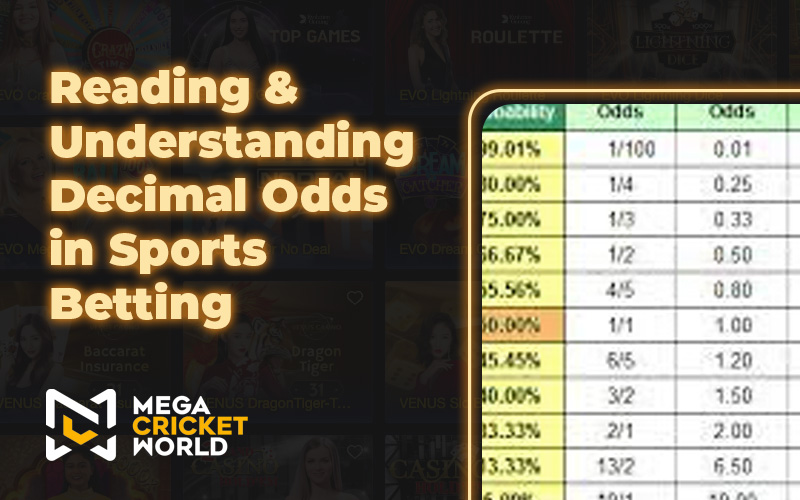It is essential for bettors to comprehend odds formats in Bangladesh’s rapidly expanding sports betting market in order to appropriately assess bets and make wise choices. Although moneyline and fractional odds are more common, understanding decimal odds offers another helpful viewpoint.
Decimal odds, which are presented as single figures with embedded profit computations, combine payment ratios and probability theory into a single measure. This article will explain what decimal odds actually mean, highlight some of their salient features, and show how using decimals in addition to more widely used forms can yield a more comprehensive analysis for well-informed sports betting. Gaining proficiency with decimal odds allows fans to extend their conceptual understanding of translating odds to possible returns and suggested probability.
What Are Decimal Odds?
Expressed as a single number (e.g. 2.45), decimal odds display the total returns from a winning bet including the initial stake, in multiple decimal place values. The key thing decimal odds show is how much punters stand to win per unit wagered, presented in an easy to understand format.
| Decimal Odds Sample Simulation | |||
|---|---|---|---|
| Decimal Odds | Implied Probability | Bet Amount (BDT) | Potential Payout (BDT) |
| 1.05 | 95.24% | 100 | 105 |
| 1.90 | 52.63% | 100 | 190 |
| 2.0 | 50.00% | 100 | 200 |
| 3.3 | 30.30% | 100 | 330 |
| 5.5 | 18.18% | 100 | 550 |
| 15.0 | 6.67% | 100 | 1500 |
| 10.5 | 9.52% | 100 | 1050 |
Key Characteristics of Decimal Odds
There are some key characteristics of decimal odds formats that are important to understand in sports betting:
Firstly, the single number expressing the odds encapsulates the total returns, comprising both the original wagered amount in addition to net winnings, in one clear number. This allows bettors to instantly understand their total prospective payout ratios.
Any decimal odds set below the benchmark 2.00 level indicate that a punter must risk more than they stand to profit. For example, odds set at 1.91 would require betting 109 units in order reach 100 units of profit. So decimals under 2.00 signify lower return on investment ratios.
Decimal odds extended beyond the 2.00 baseline convey that a successful wager will yield positive returns exceeding the original stake amount. For instance, odds of 2.20 imply that for every 100 units staked, the bettor profits 120 units on top to bring total returns to 220 units. So in essence, higher decimal figures signal greater returns per amount risked, making probability calculations
Favorites Have Lower Decimal Odds
In decimal odds, lower numbers signify higher implied probabilities of an outcome occurring. Favorites carry shorter odds closer to 2.00:
2.00 Even odds, 50% implied probability
1.80 Heavy favorite, 55.5% implied probability
Higher Decimal Odds on Underdogs
Higher decimal odds indicate underdog status, with lower implied probabilities:
5.50 Significant underdog odds, 18.2% implied probability
15.00 Heavy longshot with 6.7% implied probability
Calculating Payouts on Decimal Odd Wagers
Payout calculations are straightforward in decimal format. As it incorporates total returns, simply multiply a wager by the decimal price to calculate potential winnings.
For example, 300 Taka wagered at odds of 2.45 would calculate:
⎼ 300 x 2.45 = 735 Taka in total returns
So the 300 Taka initial wager + 435 Taka net profit = 735 Taka return.
Understanding and Comparing Key Decimal Odds
Here are some examples to better understand and compare key decimal odds:
1.05 Extreme favorite, heavy wager required for small returns
1.90 Slight favorite, wager almost doubles
2.00 Even odds, exactly double returns
3.30 Solid underdog odds nearly triple returns
10.50 Big longshot, profit potential over 10 times amount wagered
The higher the number over 2.00, the more profit potential per amount risked on underdogs.
Converting Decimal Odds to Other Formats
Decimal odds seamlessly convert to other formats including:
Fractional – Subtract 1.00 then divide into the decimal number
(Ex. 2.45 Decimal -> 2.45 – 1.00 = 1.45/1 Fractional)
Moneyline – Subtract 1.00, then multiply by 100 for returns per 100 wagered
(Ex 2.45 -> 2.45 – 1 = 1.45 x 100 = +145 Moneyline)
Tips for Using Decimal Odds Efficiently
Some key tips for utilizing decimal odds effectively:
Recognize favorites by lower decimal odds near 2.00 – Odds set closer to the baseline 2.00 number indicate the selection is more likely to win in the eyes of bookmakers. These favorites require a larger wager for more modest potential returns given higher expected win probability.
Use higher decimals to identify and calculate underdog payouts – Longshot picks can be spotted more easily in decimal formats by numbers exceeding 2.00 by wider margins. These more attractive payout ratios compensate bettors appropriately for backing less probable outcomes.
The higher the decimal, the greater the returns for underdogs – As decimal odds climb further from the baseline 2.00 level, the implied probabilities drop while prospective payout ratios rise. This reflects the increased risk and lower expectations of success factored into juicier potential rewards for accurately predicting underdog upsets.
Conclusion
Calculate returns easily by multiplying decimal price by wager amount
So in summary, decimal odds offer a straightforward way to compare probabilities and calculate potential payouts across all sports betting in Bangladesh. Using decimal formats alongside other odds types provides a comprehensive overview for making informed wagering decisions.
Aside from decimal odds, players that are new to sports betting can also learn how American Odds and Fractional odds work.

















